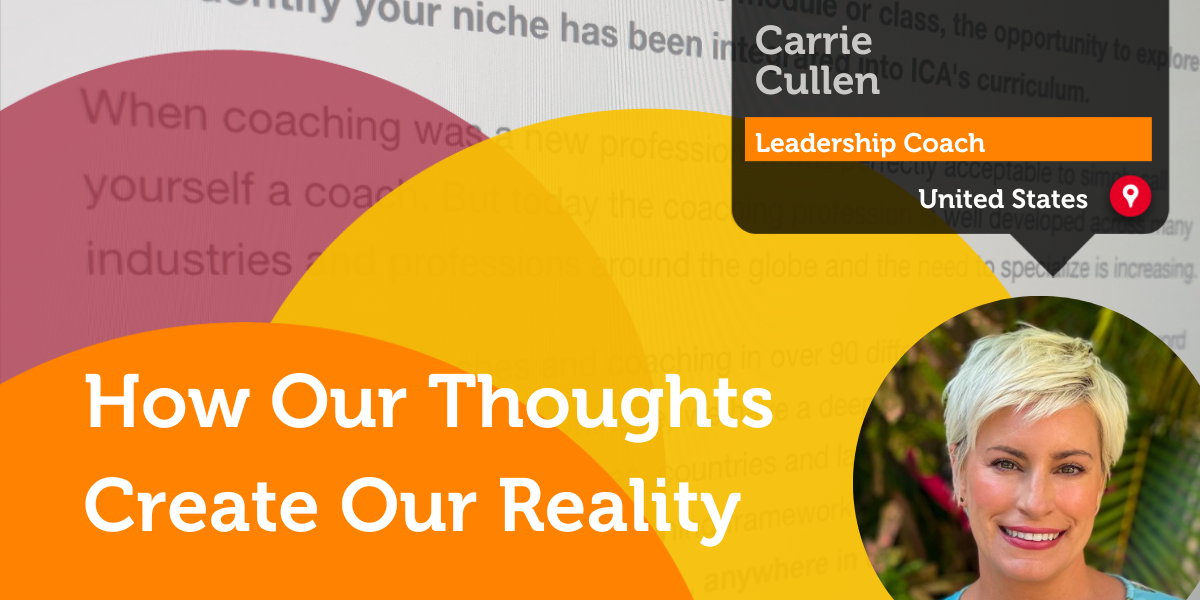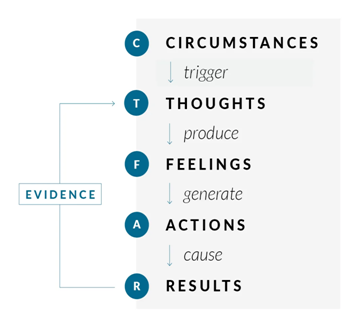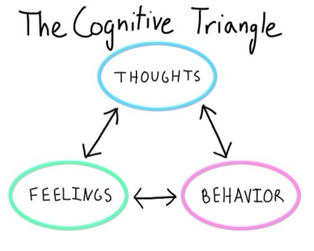A Research Paper By Carrie Cullen, Leadership Coach, UNITED STATES

How Our Thoughts Create Our Reality: Your Thoughts Influence Your Feelings and Behavior
Whether you think you can, or you think you can’t, you’re right.– Henry Ford
Prior to joining ICA, I worked in the advertising sales industry, managing salespeople. Each year, it was fascinating to see who succeeded on the team and who did not. I was always curious to know what the ‘secret’ was to a really good win. And, when the deal didn’t go through, I was curious about that as well. For a sale, I’d ask the salesperson, “what do you think was the key component here?” And, if the deal didn’t go through “what do you think was missing here?” And, I would listen hard. What became clear over time was that the mindset of the salesperson was the #1 factor. There were some people on the team who 100% believed in themselves, their abilities, their relationships with our clients, and our product. These were the team members who, year after year succeeded in reaching their sales goals. Then, there were others on the team who were ambivalent or lacked any sort of belief and they struggled to reach their goals if they did at all.
This got me very interested in topics such as mindset, mind/thought management, neuroplasticity, and even esoteric concepts such as the law of attraction. What really drove this curiosity was a desire for some sense of control in a world that sometimes felt out of my hands. In essence, I was looking for a surefire way or formula to be successful and to help my team be successful.
In my years of study and research, it seems the most compelling answer is the notion that our thoughts create our reality. Furthermore, learning that we can actually choose our thoughts is incredibly powerful! I had no idea prior to this coaching journey that we can decide which thoughts we accept, which thoughts we reject, which thoughts serve us, and which thoughts do not. Turns out, my brain was running wild and out of control!
After all this research, I now know that thoughts are things we can choose. Like a buffet meal, we can decide which thoughts we want to ‘put on our plate’ and which thoughts just aren’t worth the calories! This knowledge was incredibly comforting and empowering.
Explanation of How Our Thoughts Create Our Reality
Here’s the thing about thoughts:
According to the Cleveland Clinic, the brain processes about 70,000 thoughts per day! AND……
- Most people take the thoughts they think to be truths
- Most people think their thoughts automatically
- Most people think they aren’t in control of their thoughts
- Most people can’t even really identify their thoughts
This is a lot of brain power on auto-pilot!
Now I know that every thought we think can be a choice we make. I know now that I can retrain my mind to think in ways that bring me positive emotion and therefore, positive results. I realize that it is not just what I happen to think at any moment that will determine the outcome of my life, but what I WANT to think that will bring me everything I desire and more. – Brooke Castillo

Brooke Castillo is a multi-million dollar coach in the United States who developed a coaching tool called The Model.
The Model is a way to linearly examine any circumstance. In Castillo’s The Model, the C or Circumstance is ALWAYS neutral. She emphasizes in her teachings that it’s our thought about the circumstance that gives the circumstance its meaning thereby setting a domino effect into motion.
Brooke Castillo’s Model is not an original idea, however. It is rooted in the work of Dr. Aaron Beck, founder of Cognitive Behavior Therapy. Below, the Cognitive Triangle illustrates the interconnectedness between our thoughts, feelings, and actions.
And, while the Cognitive Triangle was developed for the purposes of CBT therapy, it’s a very helpful tool for day-to-day thought and mindset management. For the most part, it seems as though people understand the connection between feelings and behavior, but leave the ‘thought’ piece out.

Castillo’s Model is a bit different than the Cognitive Triangle in its more linear approach, which starts with the Thought and ends with the Result (which is an outcome of action/behavior). Whereas The Cognitive Triangle is circular in its approach thus showing a more circular interconnectivity between thought, feeling, and behavior. With The Cognitive Triangle having its roots in therapy, and The Model having its roots in coaching, this difference makes sense, for coaching is about forward motion, and therapy is about understanding deep patterns.
Warning: when feelings become the means of thinking, or if we cannot think greater than how we feel, we can never change. To change is to think greater than how we feel. To change is to act greater than the familiar feelings of the memorized self.― Dr. Joe Dispenza
The work of Dr. Joe Dispenza is also centered around this very idea; that your thoughts create your reality. In essence, he writes about how you MUST get control of your thoughts for if you do not, you will continue to create the same results. Essentially, if you are thinking and feeling the same things you always have, you are essentially living in the past, for you will be getting the same results you have always gotten. The difficulty lies in allowing your brain to think differently, feel differently, and become different. It is simple but it’s not easy.
Here is where neuroscience comes in. Because our brain is essentially meant to keep us safe, it likes predictability. Our brain loves routine, habit, and staying in our comfort zone. Over time, through our thoughts, habits, feelings, and behaviors, we build neural pathways. These neural pathways are like information highways and the more habituated we are in our thoughts, habits, feelings, and behaviors, the deeper the grooves are in these neural pathways. Where they might start off like a small footpath, over time they become like well-traveled highways. This is why it can be really difficult to change. Anyone who’s tried to quit a bad habit understands this first-hand.
Psychologist Deann Ware, Ph.D., explains that when brain cells communicate frequently, the connection between them strengthens and “the messages that travel the same pathway in the brain over and over begin to transmit faster and faster.” With enough repetition, these behaviors become automatic. Reading, driving, and riding a bike are examples of complicated behaviors that we do automatically because neural pathways have formed. – www.healthtransformer.co
In order to change behaviors, we literally have to build new neural pathways. And, it can be uncomfortable, and take lots of energy. Subconsciously, our brain doesn’t like change, nor does it like to waste energy, so it will work to keep us ‘comfortable’. This can be incredibly challenging.
Dissonance is exhausting – both for your brain and for you. If your two brains are in a constant state of neural dissonance, always fighting each other and undermining your ability to succeed at anything, it’s like having one foot on the gas and one foot on the brake. It’s not only tiring – it’s extremely frustrating! – John Assaraf
The good news is that “you can teach an old dog new tricks.” But, you have to build new neural pathways in order to do it.
In his book, Innercise, author John Assaraf identifies three neuro muscles; Awareness, Intention, and Action. He describes each as:
- Awareness: your ability to monitor your own mental, emotional, and physical state. Awareness is critical because it allows you to observe your habitual patterns and make changes.
- Intention: This term refers to deciding how you want to think, feel and act. When you begin to realize that your thoughts, feelings, and actions can be choices you make, you can choose more of what you want, and also more of what you don’t want.
- Action: This term is all about executing new ways of thinking, feeling, and behaving. Taking healthy, consistent, constructive action is one of the best ways to build your brain fitness. When you take the right actions, in the right order, at the right time, you certainly increase your chances for success. But whether you succeed or fail, the action will strengthen your brain by learning – that strengthening is not a matter of chance, but rather one of certainty
John Assaraf, Innercise:
The key to consciously choosing better-serving thoughts is awareness. In order to do this, you must first observe your thoughts; put distance between them and yourself. This gives you an understanding that you are not your thoughts. Once you have this bit of space, you begin to understand that your thoughts are not truths, they are not you, and they can be intentionally chosen and/or discarded if they don’t serve you.
However, becoming aware of, and observing our thoughts takes practice and patience. For so many of us, the idea of slowing down is challenging enough. Additionally, we take our thoughts to be truths; to our own detriment in many cases. So, in order to really change, first we have to have 2 awarenesses:
- I’m having these thoughts
- I’m aware that these thoughts I’m having aren’t necessarily truths
When we get curious, we can really have fun with our brains! Some questions we might ask include (but are not limited to):
- What thoughts am I having about this situation/circumstance?
- Why did my brain serve me that thought?
- What’s true about this thought?
- Is this thought serving me? If so, how?
And, once we have an understanding of this, we can start to shift to neutral or even positive thinking if it feels authentic to us. Some questions to ask include (but are not limited to):
- What else might be true?
- What’s another way to look at this?
- What do I want to think about this situation? Does that feel believable to me?
- What if it has nothing to do with me?
- What if it doesn’t mean what I think it means?
These questions open up the thinking and hold space for new perspectives and thoughts to bubble up. From there, we can examine whatever new feelings arise as a result and then choose our actions intentionally. We can respond vs. react.
For so many, this is a difficult process. Thoughts and ideas can be so deeply programmed, and the neural pathways so deeply entrenched, that the idea that they can even be examined and questioned can come as a surprise to some!
This is where coaching can be of great service. Coaching also provides an amazing container to uncover these thoughts or limiting beliefs and shine a light on them. Coaching provides a safe, non-judgmental space to explore, and for the client to move forward intentionally and thoughtfully.
This ability to move forward with intention is incredibly empowering. No longer are you moving through the world feeling out of control. You come to understand that while circumstances can be out of your control, the meaning you assign to each circumstance (by your thoughts and beliefs) is a matter of choice.
Pain is a physical sensation or signal indicating an event within the body. Suffering is the interpretation of that event and involves thoughts, beliefs, or judgments,4,5 and reflects the human experience of pain.
Inevitably, we are all going to feel pain in this life. Circumstances will happen that are painful. It is the nature of life. But, choosing our interpretation of the circumstances will decide if we simply endure the pain or if we suffer. We don’t have to suffer. We choose to.
Additionally, we can harness this power to create our own reality in a positive way. If we can zero in on thoughts that serve us, and that cause positive feelings which cause positive and inspired actions, we can create the results that we want. Science and data back this up over and over again. How amazing our brains truly are!
References
www.livestrong.com
www.healthtransformer.co
www.healthybrains.org
www.ncbi.nlm.nih.gov
Joe Dispenza, Breaking the Habit of Being Yourself: How to Lose Your Mind and Create a New One
Brooke Castillo, Self-Coaching 101
Eckart Tolle, A New Earth: Awakening to Your Life’s Purpose
Michael A. Singer, The Untethered Soul: The Journey Beyond Yourself
Innercise: the New Science to Unlock Your Brain’s Hidden Power. John Assaraf. Waterside Press. 2018